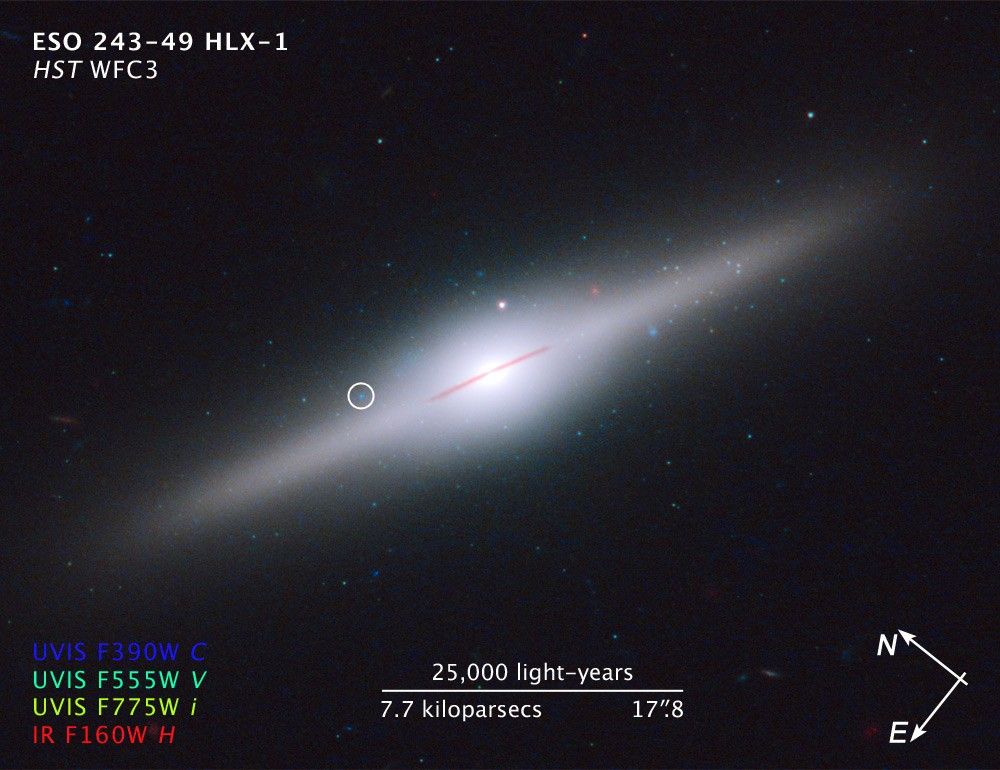1 min read
Compass and Scale Image of ESO 243-49 HLX-1

About the Object
- R.A. PositionR.A. PositionRight ascension – analogous to longitude – is one component of an object's position.01h 10m 27.73s
- Dec. PositionDec. PositionDeclination – analogous to latitude – is one component of an object's position.-46° 4' 27.3"
- ConstellationConstellationOne of 88 recognized regions of the celestial sphere in which the object appears.Phoenix
- DistanceDistanceThe physical distance from Earth to the astronomical object. Distances within our solar system are usually measured in Astronomical Units (AU). Distances between stars are usually measured in light-years. Interstellar distances can also be measured in parsecs.290 million light-years (100 million parsecs)
About the Data
- Data DescriptionData DescriptionProposal: A description of the observations, their scientific justification, and the links to the data available in the science archive.
Science Team: The astronomers who planned the observations and analyzed the data. "PI" refers to the Principal Investigator.The image was created from Hubble data from proposal 12256: S. Farrell (Sydney Institute for Astronomy, University of Sydney), C. Knigge and T. Maccarone (University of Southampton), A. Gosling (University of Oxford), M. Servillat (Harvard University), K. Wiersema (University of Leicester), and N. Webb, D. Barret, and O. Godet (Centre d' Etude Spatiale des Rayonnements, Toulouse, France) - InstrumentInstrumentThe science instrument used to produce the data.HST>WFC3/UVIS and HST>WFC3/IR
- Exposure DatesExposure DatesThe date(s) that the telescope made its observations and the total exposure time.September 23-24, 2010, Exposure Time: 50 minutes
- FiltersFiltersThe camera filters that were used in the science observations.WFC3/UVIS: F390W (C), F555W (V), and F774W (i) WFC3/IR: F160W (H)
- Object NameObject NameA name or catalog number that astronomers use to identify an astronomical object.ESO 243-49 HLX-1
- Object DescriptionObject DescriptionThe type of astronomical object.Edge-on Spiral Galaxy with Black Hole
- Release DateFebruary 17, 2012
- Science ReleaseNASA’s Hubble Spots a Relic from a Shredded Galaxy
- Credit

This image is a composite of separate exposures acquired by the WFC3 instrument on HST. Several filters were used to sample broad wavelength ranges. The color results from assigning different hues (colors) to each monochromatic (grayscale) image associated with an individual filter. In this case, the assigned colors are: Blue: F390W (C) Aquamarine: F555W (V) Yellow/green: F774W (i) Red: F160W (H)

Related Images & Videos

Black Hole ESO 243-49 HLX-1
This spectacular edge-on galaxy, called ESO 243-49, is believed to be home to an intermediate-mass black hole that may have been stripped off of a cannibalized dwarf galaxy. The estimated 20,000-solar-mass black hole lies above the galactic plane. This is an unlikely place for...
Share
Details
Claire Andreoli
NASA’s Goddard Space Flight Center
Greenbelt, Maryland
claire.andreoli@nasa.gov































